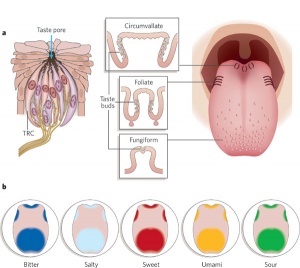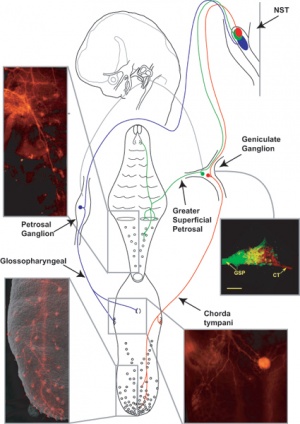Sensory - Taste Development: Difference between revisions
No edit summary |
No edit summary |
||
| Line 13: | Line 13: | ||
* <ref><pubmed>19363153</pubmed></ref>"Mammalian taste buds have properties of both epithelial and neuronal cells, and are thus developmentally intriguing. Taste buds differentiate at birth within epithelial appendages, termed taste papillae, which arise at mid-gestation as epithelial thickenings or placodes. ...we demonstrate that Shh-expressing embryonic taste placodes are taste bud progenitors, which give rise to at least two different adult taste cell types, but do not contribute to taste papillae. Strikingly, placodally descendant taste cells disappear early in adult life." | * <ref><pubmed>19363153</pubmed></ref>"Mammalian taste buds have properties of both epithelial and neuronal cells, and are thus developmentally intriguing. Taste buds differentiate at birth within epithelial appendages, termed taste papillae, which arise at mid-gestation as epithelial thickenings or placodes. ...we demonstrate that Shh-expressing embryonic taste placodes are taste bud progenitors, which give rise to at least two different adult taste cell types, but do not contribute to taste papillae. Strikingly, placodally descendant taste cells disappear early in adult life." | ||
==Gustatory cranial sensory neurons== | |||
<ref><pubmed>17826760</pubmed></ref>"Cranial nerves VII, IX and X provide both gustatory (taste) and non-gustatory (touch, pain, temperature) innervation to the oral cavity of vertebrates. Gustatory neurons innervate taste buds and project centrally to the rostral nucleus of the solitary tract (NTS), whereas neurons providing general epithelial innervation to the oropharynx project to non-gustatory hindbrain regions, i.e., spinal trigeminal nucleus. In addition to this dichotomy in function, cranial ganglia VII, IX and X have dual embryonic origins, comprising sensory neurons derived from both cranial neural crest and epibranchial placodes. We used a fate mapping approach to test the hypothesis that epibranchial placodes give rise to gustatory neurons, whereas the neural crest generates non-gustatory cells. Placodal ectoderm or neural crest was grafted from Green Fluorescent Protein (GFP) expressing salamander embryos into unlabeled hosts, allowing us to discern the postembryonic central and peripheral projections of each embryonic neuronal population. Neurites that innervate taste buds are exclusively placodal in origin, and their central processes project to the NTS, consistent with a gustatory fate. In contrast, neural crest-derived neurons do not innervate taste buds; instead, neurites of these sensory neurons terminate as free nerve endings within the oral epithelium. Further, the majority of centrally directed fibers of neural crest neurons terminate outside the NTS, in regions that receive general epithelial afferents. Our data provide empirical evidence that embryonic origin dictates mature neuron function within cranial sensory ganglia: specifically, gustatory neurons derive from epibranchial placodes, whereas neural crest-derived neurons provide general epithelial innervation to the oral cavity.' | |||
== References == | == References == | ||
Revision as of 23:59, 1 September 2010
Introduction


These notes introduce the development of the sense of taste which can divided into five basic tastes: bitter, salty, sweet, umami (savoury) and sour. Current research appears to have displaced the historic concept of a tongue "map".
A study in rat suggests that neonatal changes in circumvallate papillae may result in postnatal changes in "taste".[3] In frogs, a large taste disc (TD) is the largest vertebrate gustatory organ. Postnatally, the sense of taste is also closely related to the sense of smell.
| Taste Links: Introduction | Student project | Tongue Development | Category:Taste | ||
|
| Senses Links: Introduction | placode | Hearing and Balance hearing | balance | vision | smell | taste | touch | Stage 22 | Category:Sensory |
Some Recent Findings
- [4]"Mammalian taste buds have properties of both epithelial and neuronal cells, and are thus developmentally intriguing. Taste buds differentiate at birth within epithelial appendages, termed taste papillae, which arise at mid-gestation as epithelial thickenings or placodes. ...we demonstrate that Shh-expressing embryonic taste placodes are taste bud progenitors, which give rise to at least two different adult taste cell types, but do not contribute to taste papillae. Strikingly, placodally descendant taste cells disappear early in adult life."
Gustatory cranial sensory neurons
[5]"Cranial nerves VII, IX and X provide both gustatory (taste) and non-gustatory (touch, pain, temperature) innervation to the oral cavity of vertebrates. Gustatory neurons innervate taste buds and project centrally to the rostral nucleus of the solitary tract (NTS), whereas neurons providing general epithelial innervation to the oropharynx project to non-gustatory hindbrain regions, i.e., spinal trigeminal nucleus. In addition to this dichotomy in function, cranial ganglia VII, IX and X have dual embryonic origins, comprising sensory neurons derived from both cranial neural crest and epibranchial placodes. We used a fate mapping approach to test the hypothesis that epibranchial placodes give rise to gustatory neurons, whereas the neural crest generates non-gustatory cells. Placodal ectoderm or neural crest was grafted from Green Fluorescent Protein (GFP) expressing salamander embryos into unlabeled hosts, allowing us to discern the postembryonic central and peripheral projections of each embryonic neuronal population. Neurites that innervate taste buds are exclusively placodal in origin, and their central processes project to the NTS, consistent with a gustatory fate. In contrast, neural crest-derived neurons do not innervate taste buds; instead, neurites of these sensory neurons terminate as free nerve endings within the oral epithelium. Further, the majority of centrally directed fibers of neural crest neurons terminate outside the NTS, in regions that receive general epithelial afferents. Our data provide empirical evidence that embryonic origin dictates mature neuron function within cranial sensory ganglia: specifically, gustatory neurons derive from epibranchial placodes, whereas neural crest-derived neurons provide general epithelial innervation to the oral cavity.'
References
Reviews
Articles
Search PubMed
Search May 2010
- Taste System Development - All (320) Review (64) Free Full Text (78)
- Tongue Development - All (2804) Review (258) Free Full Text (519)
Search Pubmed: Taste System Development | Tongue Development
Glossary Links
- Glossary: A | B | C | D | E | F | G | H | I | J | K | L | M | N | O | P | Q | R | S | T | U | V | W | X | Y | Z | Numbers | Symbols | Term Link
Cite this page: Hill, M.A. (2024, April 25) Embryology Sensory - Taste Development. Retrieved from https://embryology.med.unsw.edu.au/embryology/index.php/Sensory_-_Taste_Development
- © Dr Mark Hill 2024, UNSW Embryology ISBN: 978 0 7334 2609 4 - UNSW CRICOS Provider Code No. 00098G